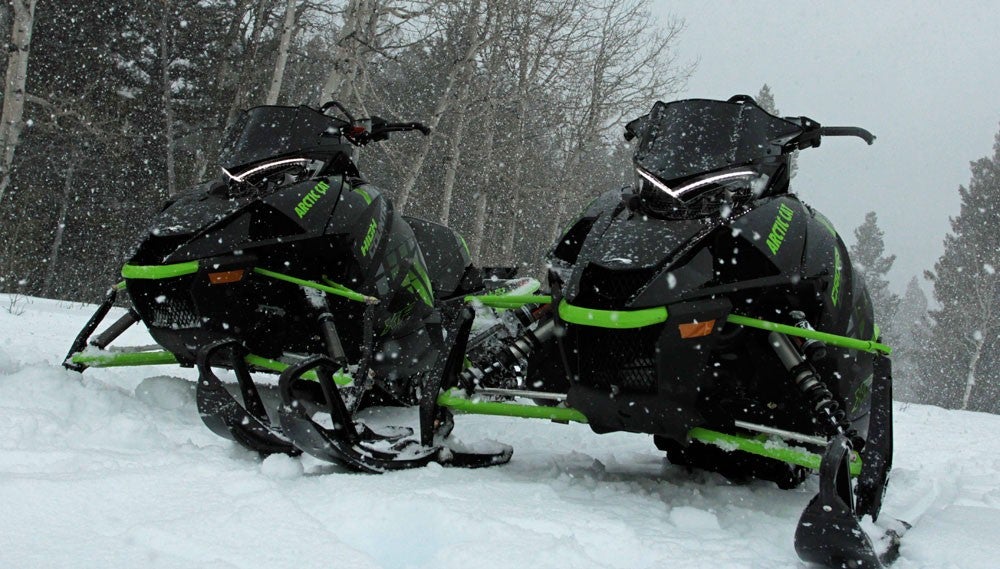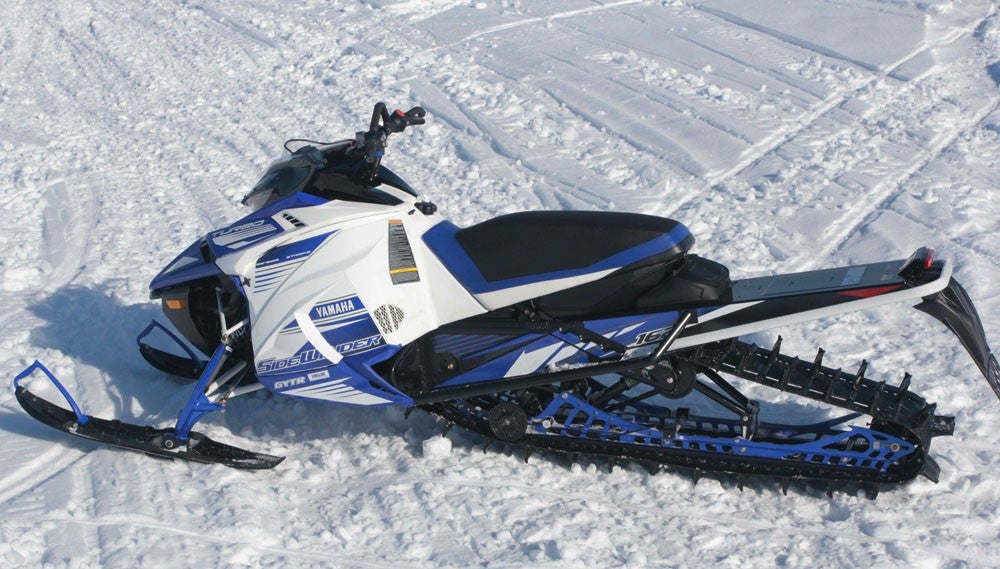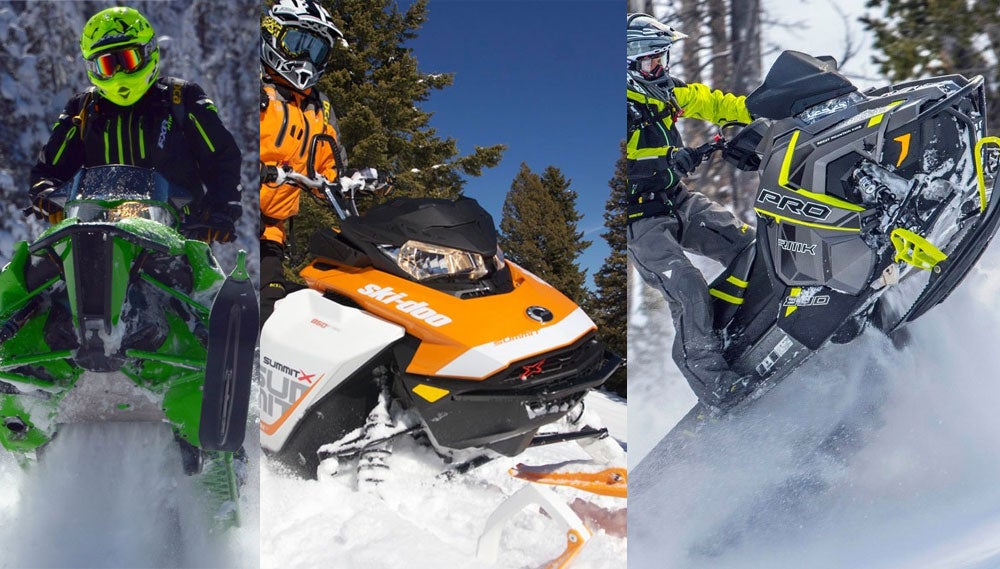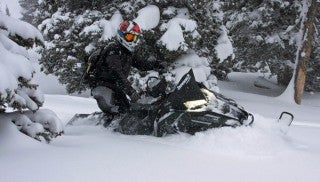Thoughts from High atop the Mountain
What we learned about the 2017 mountain snowmobiles
After riding the 2017 mountain snowmobiles at various manufacturer sneak peek events and at this year’s model year 2017 roundup in West Yellowstone in February, we’ve gathered our thoughts. Well, let’s call it opinions on the 2017 mountain-specific snowmobiles; this is where we let the keyboard free wheel with our mind and fingers.
Ski-Doo
No doubt about it, an 850 in a Summit is big news. We’ve ridden the 2017 Summit in the deepest goomba, the stickiest schleck and on the hardest tracked up shineola one could imagine. The 850 Summit X and SP, both the 154 and 165, are manageable, agile and quick responding. If you have slow firing synapses and muscles, then this may not the mountain muscle snowmobile for you. On the other hand, if you are looking at staying in the mountain slaying game well into your gray hair years, then this may very well be the mountain snowmobile for you – it is wildly agile, nimble and effortless.

The monster Summit X 850 in Gen-4 REV is an agile running back. Full of life and spirit. It should come with the Freeride’s wide-tip ski and less white. These are minor nits for a homerun hit mountain snowmobile.
The Gen-4 REV Summit 850 X looks good in white and orange (one of two color combinations), but when white is the main color, and it fills the bottom side panels, it typically won’t age well as the season progresses. For the white and orange Summit X, the bottom side panels would do well if black. Given that is not an option, we recommend the black Summit X if you are an OCD clean freak, like this article’s author.
The pointy mountain ski on the Summit is a good ski, except for its narrow tip. We recommend purchasing Ski-Doo’s accessory slip-on cover to expand the tip’s width. When taking the Summit X past a drift or large snow accumulation, the narrow ski tip will stab the snow and suck in machine and driver. It needs to float when leading into a snow boulder. Not much to gritch and groan about the Summit X.
The 154 Freeride and 163 Freeride are quick, fun and durable freestylists, but these will fade fast into yesteryear unless the Freeride lands in the Gen-4 REV chassis with 850 soup. The Freeride is loud in color and it has the reliable 800 E-Tec motor that easily starts and runs. Its ski should trickle across to the Summit; its tip is wide, molded that way from the factory. The Freeride should have a one- to two-inch lower handlebar. The blue color is a like-it-or-not color – totally up to individual tastes.

Loud in color, the XM-RS Freeride is a freestylist’s dream mountain hucker. We like this snowmobile. But, is it time to give it 850 power, Gen-4 underpinnings and a factory-installed lower handlebar post?
The Summit X 174 remained as the 2016 except wrapped in orange and cream-white. Like the Freeride, it will fall away for 2017 sales as the 850 Summit X and SP crush mountain tops. Like the Freeride comment from above, why Ski-Doo did not launch a Gen-4 850 Summit X 174 baffles us. But, we can only assume Ski-Doo will show off a new 174 next year, if it is not held in purgatory.
On the deep-powder crossover side, the Renegade Backcountry X remains a darling crosser on our fast fave list. It is not ripped and clean like the Gen-4 Renegades with Ski-Doo’s new 850. But, it is glued to the trail and at high speeds, is comfortable as a trail machine, and adept at being a backcountry boondocker. We would like to see the Renegade Backcountry X stretch out to a 154, have the 850 motor and 2.0-inch or 2.25-inch paddle track, and be wrapped around the Gen-IV chassis. Time will tell.
Polaris
The new one-seven-four RMK Pro on a scale of 1 to 10 is a 12 (1+7+4). Polaris, being the master at repackaging and shipping out new niche mountain sleds waited, not until the public was ready, but when Polaris felt the 174 was properly calibrated, engineered and efficient. Polaris did not rush.
The 174 AXYS RMK Pro 800 will be a huge seller. It may not overtake the 155 or the 163 in shear sales numbers, but it is a steady, stable, and oh-so-planted ultra-long track AXYS RMK Pro, that we believe for this year will directly affect Ski-Doo’s sales of the 174 XM Summit X T3.

Polaris did not jump the starting gun to deliver a 174 because Ski-Doo did. It engineered from inception, a rear suspension that is meant to be a 174, not a stretched 163.
However, we encourage Polaris to give its 174 customer the Spring-buy option between the Series 6 2.6-inch track and Series 7 3.0-inch track. With the snowmobile so planted, it may behoove Polaris to give customers the option of stuffing the 2.6-incher under the 174 tunnel – to spin the track faster and make the 174 a February through March snowmobile.
We like how Polaris is marketing its SKS Pro 155. It is a darling on the snow. Though it has a front heat exchanger and bogie wheels, it is the ultimate combination trail and deep powder weapon. We did not believe we could find a Polaris trail/crossover/deep-powder player snowmobile that surpassed our love affair with the deep-powder Switchback Assault 800, but we have in the SKS Pro 155.

The SKS Pro is as dedicated to powder play as it is to trail running and meadow mashing. The Series 6.0 track mated to this 155 will take on the deepest snow, while the skidframe loaded with bogie wheels, allows it to burn trails with ease.
A sweetheart from Polaris is its Switchback Assault 600 S. Whew…it is fast, dialed in, railed-and-nailed in the powder (marginal depth) and on the trails. As a crossover, it is near perfect with its abundance of storage bags and trail power. We hope customers pay particular attention to this crosser.
Polaris’ AXYS RMK Pro sales may take a hit through Polaris’ Spring-buy program and through the upcoming winter season as the 850 Summit X sales heat up; it is the new lean and mean wondersled on the snow. Competition is good though, as one improves, the other OEMs step up and improve as well. Lastly, Polaris has a nimble and light chassis in the AXYS RMK Pro and SKS Pro, but it would not be wise for Polaris to become comfortable; it should ever be diligent looking at its competitors.
Arctic Cat
The Thief River Falls Company continues to refine its ProCross and ProClimb chassis. We believe Arctic Cat’s engineers when they tell us they’ve been working their butts off to hone and polish these two chassis. But, it may be time to fully re-engineer the two chassis, at least the ProClimb, by starting from scratch on a new Generation 2 ProClimb. Ski-Doo was right on track to reinvent its Pyramidal REV chassis – to start all over. Also, pair down the M8000 offerings – MC, Limited, Sno Pro and SE/ES are two too many.
But, in all fairness, the 2017 Mountain Cat, M8000 Limited, M8000 Sno Pro are wicked fun.

The Mountain Cat has purpose and though the Chassis is in fifth year, Arctic Cat has made it nimble. It is a serious boonie basher.
The Mountain Cat (MC) with its dropped and rolled chaincase, cinched in lower side panels and tightened and narrowed runningboards, give the sled the finesse it needs and riders demand. A sweetheart it is. In fact, it is as nimble as the new 850 Summit – one needs be alert as the chassis receives driver input and responds with an elevated response. It’s not a snowmobile for slow thinkers.
Though the MC rocks the mountains, customers continue to view the ProClimb as yesterday’s chassis, and they know a new 800 will come soon, based on the domestic-built 600. If (or “Since”) a new 800 is coming (when, we do not know), perhaps it’s time to punch it out to an 850 or 880 before stuffing it in a chassis, and put the mountain line on a serious diet – given the company needs to make up ground. We also believe Cat should purchase Yamaha’s new MTN ski – it is the best ski for the ProClimb chassis.
Less is more, as in less weight equals more sales.
More is more, where more displacement, more horsepower and torque equal sales.
Arctic Cat’s new CEO and his administration seem serious on moving the company to competitive status. We do not doubt Cat’s new energy. But, Arctic Cat needs to do something now. The 850 Summit will siphon off sales from Arctic Cat and, perhaps, Polaris as well.
Given all this, though, the Mountain Cat and M8000 Limited are two musclesleds we have no problem riding in the boonies; we’ll stack these 800s up against the competitors without worry; but, it’s Cat’s dealers feeling the pain, not us.
Now, Cat’s M6000 Sno Pro is mighty fine and wholly underestimated for the tough baby-8 it is; Cat needs to push this product more.

Twin XF 9000s, the ProClimb High Country and ProCross XF Cross Country are lighting fast crossers with Yamaha’s quiet and muscular 998 turbo.
Continuing, Cat has its XF 9000 Cross Country and High Country with Yamaha’s new 998 turbocharged motor and these two crossover snowmobiles exceed our expectations for fun and power. The Cross Country in the ProCross chassis and High Country in the ProClimb chassis handle the motor’s turbo output quite well. But, we’d like to see a Gen-2 of these two chassis.
Yamaha
This is a four-stroke company. Its line of snowmobiles with electronic fuel injected four- and three-cylinder motors are snowmobiles that live forever. But, when you look at the Apex, for example, it’s been around for more than 10 years; an Apex is an Apex is an Apex. Yet, in the mountain world, we focus on the Viper and Sidewinder models.
Speaking of Sidewinder, the M-TX in particular, Yamaha and fellow turbo partner, Arctic Cat, built a remarkable sidemount turbocharger for the 998 three cylinder four-stroke motor. In contrast to our ballyhooing about weight, we cut some slack to Yamaha for its Sidewinder M-TX being hefty. The company went all conservative on us by making the Sidewinder M-TX as tough as they could to assure the chassis would handle the loads and more so, the motor could handle pressures from boost and compression.

Yamaha’s turbocharged Sidewinder M-TX is a 180- to 185-horsepower mountain muscle snowmobile that is quiet in its hard hit delivery.
This does not mean we do not wish the Sidewinder M-TX was lighter; we do, at least equal in weight to the Viper M-TX, but we get it – we understand Yamaha’s thinking – we accept fact as it is.
The 998 turbo is a marvel, how it handles/manages pressure on the downstroke and upstroke is remarkable. The motor’s method to induct air, compress the air, manage boost for changing elevations and manage overboost is engineering excellence.
Where a little item means much more than the item itself, we find Yamaha’s new MTN ski, both on the Sidewinder M-TX and Viper M-TX to be a stellar ski, where it delivers huge paybacks, with interest. Cat would do well in buying a truckload of these skis from Yamaha.

Yamaha’s Viper M-TX line with the 1049 Genesis motor is a viable mountain overachieving mountain snowmobile that is under appreciated by the masses, when it should not be.
Yamaha is a high-end four-stroke snowmobile company that produces innovative, quality-built and tough products.
And So
These are but a few free-wheeling thoughts, stuffed into a small chunk of electron web space. As we make our way down from the mountain top, we will give thought to our choices for Mountain Snowmobile of the Year, Most Improved Mountain Snowmobile of the Year, Four-Stroke Mountain Snowmobile of the Year, and Deep Powder Crossover Snowmobile of the Year.










 Your Privacy Choices
Your Privacy Choices